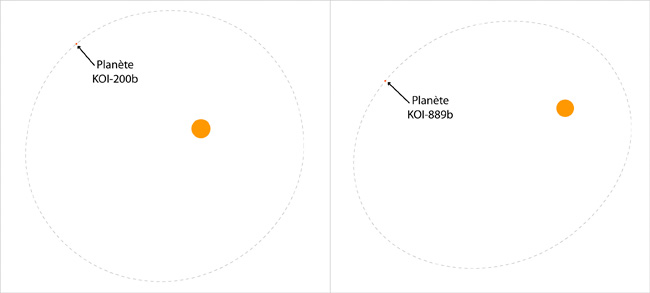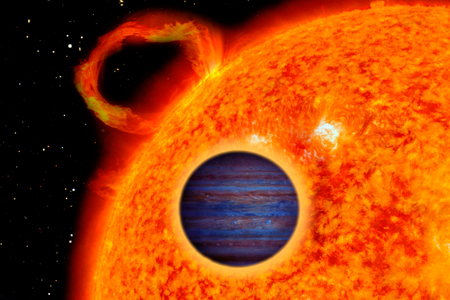Detection of two extrasolar planets with the Kepler, SOPHIE and HARPS-N instruments
Two new extrasolar planets have been identified and characterized thanks to combined observations from the Kepler space telescope and the spectrographs SOPHIE and HARPS-N respectively mounted at the Observatoire de Haute-Provence (France) and the Telescopio Nazionale Galileo (Italy). These two planets are among the first ones detected with HARPS-N, a new high-accuracy spectrograph. The team that announced these planets obtained time on the Italian telescope through the OPTICON program that share nights of European telescopes between astronomers. These two new planets, called KOI-200b and KOI-889b, have about the size of Jupiter but are orbiting in less than 10 days on eccentric orbits. These new results help to understand the evolution of planets located very close to their star.
Already more than 800 planets have been detected around stars other than the Sun. As seen from the Earth, some of them are oriented in a way that they passe in front of their star every orbital period. These periodic transits of the planet in front of its star produce a small dip in the stellar flux. These small eclipses allow the astronomers to probe the physical proprieties of the planet and of its atmosphere. Launched after the CoRoT satellite from the French Space Agency (CNES), the Kepler space mission from NASA has identify more than 2000 stars that are likely to host transiting planets. For most of them, complementary ground-based observations are needed to establish their nature and to complete their characterization.
An astronomer team, mostly from France and including members of Institut d'astrophysique de Paris, participated to these ground-based observations using since 2010 the SOPHIE instrument, a high-accuracy spectrograph mounted at the 1.93-m telescope of (France) and specialized in this kind of studies. SOPHIE has already participate to the detection and characterization of more than fifteen Kepler planets. That observing program is now completed by new observations with the HARPS-N spectrograph, which is an even more accurate spectrograph. This new spectrograph has been installed in 2012 at the Italian 3.6-m Telescopio Nazionale Galileo, in the Canary Islands. Built by a consortium of researchers from Italy, Switzerland, United Kingdom, and United-States, one of the main objectives of HARPS-N is to study and characterize Kepler candidates. The French team was able to use this new facility thanks to the OPTICON program, a European program that shares nights between Europeans astronomers. In this context, European astronomers can have access to the French SOPHIE spectrograph and French astronomers can have access to European observatories, as in the case of the Telescopio Nazionale Galileo and its instruments.
The detection and characterization of these two Kepler planets, named KOI-200b and KOI-889b, were possible by combining the data from the two spectrographs SOPHIE and HARPS-N. The first planet has first been observed with SOPHIE and the greater precision of the HARPS-N was necessary to secure its characterization. The second one was first observed with HARPS-N and then characterized with SOPHIE. KOI-200b and KOI-889b are among the first planets announced thanks to observations performed with the new HARPS-N instruments. The planet KOI-200b is slightly larger than Jupiter and slightly less massive. With a low density, this gaseous planet orbits its star in one week. The planet KOI-889b is of the size of Jupiter but is ten times more massive. This very-massive planet is orbiting around its star in slightly less than nine days. The majority of transiting planets known so far have orbital period of less than five days. As most of the planets discovered with a longer orbital period, KOI-200b and KOI-889b were detected thanks to observations from space. These two planets have eccentric orbits: during their orbit, the distance to their star varies. This produces variations in their equilibrium temperature of several hundred of degrees in a few days. KOI-889b, which is among the most massive transiting planets discovered so far, is also among the most eccentric ones. It could have been formed by a different mechanism than less-massive planets. These two new planets will also help astronomers to better understand the gravitational interactions that play an important role in the evolution of planets very close to their host stars. Indeed, if some of these hot and giant planets are likely to fall in their host star one day, other can reach a more stable orbit.
Associated scientific publication:"KOI-200 b and KOI-889 b: two transiting exoplanets detected and characterized with Kepler, SOPHIE and HARPS-N", par G. Hébrard, J.-M. Almenara, A. Santerne, M. Deleuil, C. Damiani, A.S. Bonomo, F. Bouchy, G. Bruno, R.F. Díaz, G. Montagnier, C. Moutou, 2013, Astronomy & Astrophysics, sous presse (arXiv:1304.6002).
Contact:Guillaume Hébrard
Institut d'astrophysique de Paris (IAP) CNRS-UPMC / Observatoire de Haute-Provence
Tél. : 01 44 32 80 78 / 04 92 70 65 21
hebrard à iap.fr

The three observatories used for this study: from left to right, the Kepler space telescope, the 1.93-m telescope of Observatoire de Haute-Provence with its SOPHIE spectrograph, and the Telescopio Nazionale Galileo, mounted with the new HARPS-N spectrograph (© NASA & CNRS)

Sketchs of the two new planetary systems (© CNRS)

Artist view of one of the two new exoplanets (© Ricardo Reis, CAUP)
April 24, 2013

